
Articles on Biomedical research
Displaying 1 - 20 of 48 articles

Researchers are key to Canada’s capacity to create a high-tech economy, build the biomedical sector and seed entrepreneurial activity, but they can’t do it without research funding.

Successes in the lab mostly don’t translate to people. Research models that better mimic the human body could close the gap.

Many microscopy techniques have won Nobel Prizes over the years. Advancements like cryo-ET that allow scientists to see the individual atoms of cells can reveal their biological functions.

The proteins that cover nanoparticles are essential to understanding how they work in the body. Across 17 proteomics facilities in the US, less than 2% of the identified proteins were identical.

Guidelines and regulations weigh the medical and health benefits of animal research with researchers’ ability to ensure humane care of their subjects from start to finish.

What prompts healthy volunteers to take part in clinical research? And how are they protected?

Peer review of research sounds like it should be a conversation between equals. Instead, it can be patronizing, demanding and simply unkind. A group of journal editors thinks this should change.

Biomedical studies have traditionally used male animals and men as research subjects. That is a problem for everyone because for many diseases, there are sex differences in how they affect people.

Preclinical studies are an important part of biomedical research, often guiding future trials in humans. Failure to replicate research results suggests a need to increase the quality of studies.

Careful lab work will complement public health data as researchers worldwide focus on omicron, asking questions about contagiousness, severity of disease and whether vaccines hold up against it.

She believed and advocated that Africa needs to find solutions to its own problems and worked tirelessly to build biomedical engineering capacity across the continent.

Medical research to benefit people is first conducted in animals. Creating a new biomedical model by inserting human immune cells into pigs may lead to new insights and treatments.

While COVID-19 has highlighted the invaluable nature of medical research, it has unfortunately also seriously disrupted it. In Australia, the sector now teeters on the brink of collapse.

Canada has set aside a total of 414 million doses of different types of vaccine. Some exploit known mechanisms, others are based on previously untested approaches.

An optical sensor that can detect individual molecules promises early detection of diseases and environmental contamination.

Drawing thoughtfully on the Powerhouse Museum’s collection, this exhibition lovingly exposes the humanity behind biomedical technology.

Nanoparticles dressed up in cell membranes snag SARS-CoV-2 virus particles before they reach human cells.

A cutting edge new research project is developing Lego-like bricks made from biomaterials to replace bone fragments in shattered limbs.

The scientific community is churning out vast quantities of research about the coronavirus pandemic – far too much for researchers to absorb. An AI system aims to do the heavy lifting for them.

A biomedical researcher and pediatrician who works with Kawasaki disease and COVID-19 explains the similarities and differences in the worrisome cases doctors are starting to see.
